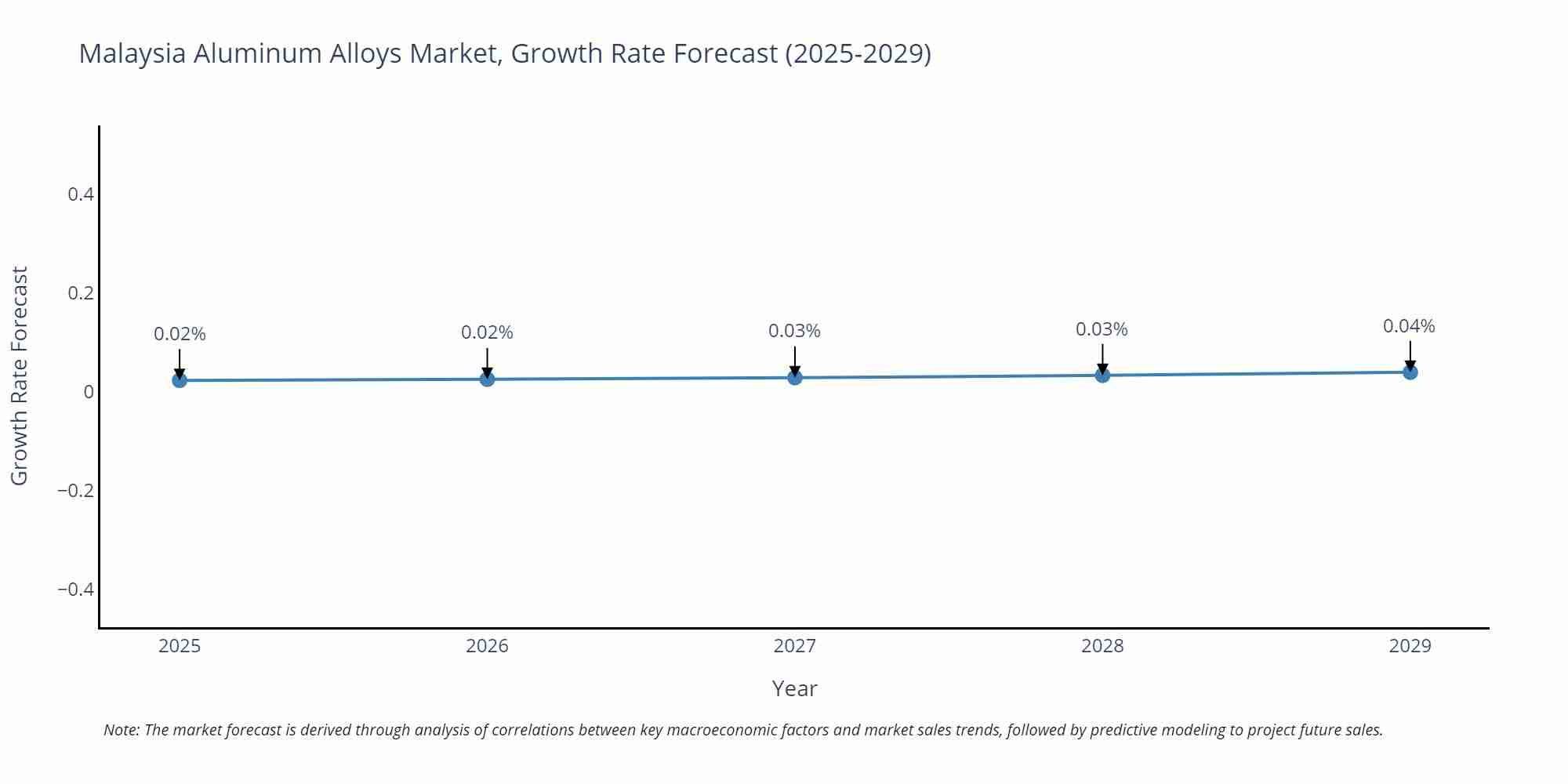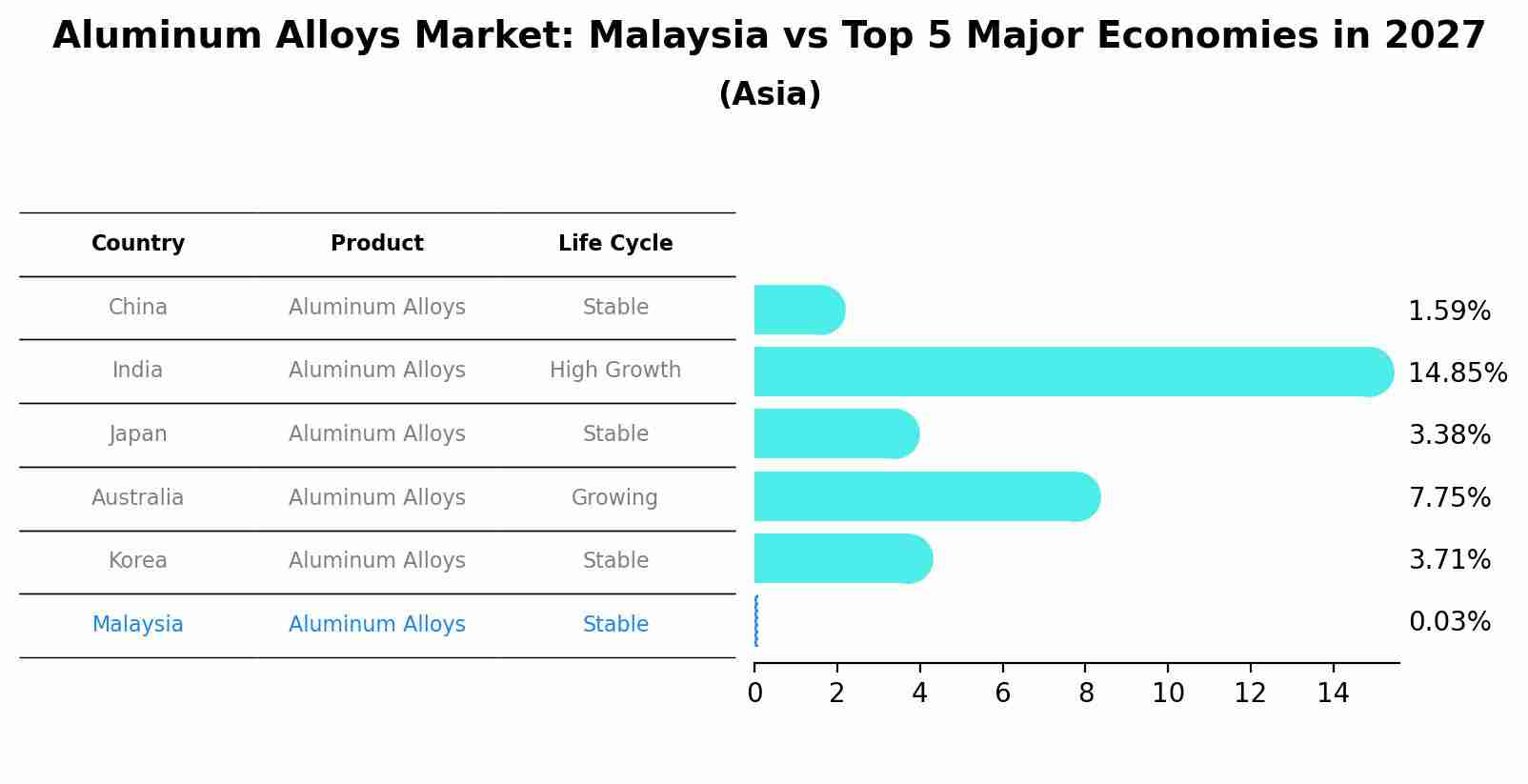Malaysia Aluminum Alloys Market (2025-2031) Outlook | Forecast, Analysis, Revenue, Companies, Trends, Value, Size, Share, Growth & Industry
| Product Code: ETC249266 | Publication Date: Aug 2022 | Updated Date: Aug 2025 | Product Type: Market Research Report | |
| Publisher: 6Wresearch | Author: Ravi Bhandari | No. of Pages: 75 | No. of Figures: 35 | No. of Tables: 20 |
Malaysia Aluminum Alloys Market Size Growth Rate
The Malaysia Aluminum Alloys Market is likely to experience consistent growth rate gains over the period 2025 to 2029. From 0.02% in 2025, the growth rate steadily ascends to 0.04% in 2029.

Aluminum Alloys Market: Malaysia vs Top 5 Major Economies in 2027 (Asia)
In the Asia region, the Aluminum Alloys market in Malaysia is projected to expand at a stable growth rate of 0.03% by 2027. The largest economy is China, followed by India, Japan, Australia and South Korea.

Malaysia Aluminum Alloys Market Synopsis
The Malaysia aluminum alloys market is experiencing steady growth driven by several factors. The automotive and aerospace industries are significant consumers of aluminum alloys due to their lightweight and corrosion-resistant properties. The construction sector also plays a vital role, utilizing aluminum alloys in various structural applications, such as beams and columns. The increasing demand for aluminum alloys in packaging, particularly in the beverage industry, is another contributing factor. With ongoing technological advancements and the focus on sustainability, the outlook for the Malaysia aluminum alloys market appears promising. Continued innovation in alloy compositions and manufacturing processes is likely to further boost the industry`s growth prospects.
Drivers of the Market
The Malaysia aluminum alloys market is expected to witness steady growth in the coming years. Several factors are driving this growth. Firstly, the construction and automotive industries, which heavily rely on aluminum alloys for their lightweight and durable properties, are anticipated to expand. Additionally, the increasing demand for aluminum in the aerospace and packaging sectors is a key driver. Moreover, the government`s focus on infrastructure development and sustainability initiatives is likely to boost the consumption of aluminum alloys. The shift towards electric vehicles (EVs) is another significant driver as aluminum alloys play a crucial role in EV manufacturing due to their lightweight nature, which enhances energy efficiency. However, fluctuating raw material prices and environmental concerns related to aluminum production processes pose challenges to the market.
Challenges of the Market
The Malaysia aluminum alloys market faces several challenges in its outlook. One key challenge is the fluctuating prices of raw materials, particularly aluminum ingots. These price fluctuations can affect the overall production costs for manufacturers, making it difficult to maintain competitive pricing. Additionally, the market must contend with environmental concerns related to the energy-intensive nature of aluminum production. Pressure to reduce carbon emissions and adopt more sustainable practices can drive up costs and require significant investments in eco-friendly technologies. Lastly, competition from alternative materials, such as composites and plastics, poses a continuous challenge, pushing the aluminum alloys market to innovate and demonstrate its unique advantages.
COVID 19 Impact on the Market
The Malaysia aluminum alloys market, like many industries worldwide, experienced significant disruptions and challenges due to the COVID-19 pandemic. The pandemic resulted in disruptions in the supply chain, reduced demand, and fluctuating prices. As industries slowed down or temporarily shut down operations to curb the spread of the virus, the demand for aluminum alloys in various applications also decreased. The construction and automotive sectors, which are significant consumers of aluminum alloys, were particularly affected. Projects were delayed or put on hold, affecting the demand for aluminum alloys in the construction sector, while the automotive industry faced reduced production and sales.
Key Players in the Market
The Malaysia aluminum alloys market is characterized by several leading players who have established a strong presence in the industry. These key players include companies such as Novelis Malaysia, NALCO, and Malaysia Aluminium, among others. These companies have a significant market share and play a crucial role in supplying high-quality aluminum alloys to various industries, including automotive, aerospace, and construction. Their advanced production facilities and continuous innovation make them leaders in the Malaysia aluminum alloys market.
Key Highlights of the Report:
- Malaysia Aluminum Alloys Market Outlook
- Market Size of Malaysia Aluminum Alloys Market, 2024
- Forecast of Malaysia Aluminum Alloys Market, 2031
- Historical Data and Forecast of Malaysia Aluminum Alloys Revenues & Volume for the Period 2021-2031
- Malaysia Aluminum Alloys Market Trend Evolution
- Malaysia Aluminum Alloys Market Drivers and Challenges
- Malaysia Aluminum Alloys Price Trends
- Malaysia Aluminum Alloys Porter's Five Forces
- Malaysia Aluminum Alloys Industry Life Cycle
- Historical Data and Forecast of Malaysia Aluminum Alloys Market Revenues & Volume By Process for the Period 2021-2031
- Historical Data and Forecast of Malaysia Aluminum Alloys Market Revenues & Volume By Die Casting for the Period 2021-2031
- Historical Data and Forecast of Malaysia Aluminum Alloys Market Revenues & Volume By Sand Casting for the Period 2021-2031
- Historical Data and Forecast of Malaysia Aluminum Alloys Market Revenues & Volume By Permanent Mold Casting for the Period 2021-2031
- Historical Data and Forecast of Malaysia Aluminum Alloys Market Revenues & Volume By End-use for the Period 2021-2031
- Historical Data and Forecast of Malaysia Aluminum Alloys Market Revenues & Volume By Transportation sector for the Period 2021-2031
- Historical Data and Forecast of Malaysia Aluminum Alloys Market Revenues & Volume By Building & Construction sector for the Period 2021-2031
- Historical Data and Forecast of Malaysia Aluminum Alloys Market Revenues & Volume By Industrial sector for the Period 2021-2031
- Historical Data and Forecast of Malaysia Aluminum Alloys Market Revenues & Volume By Others for the Period 2021-2031
- Malaysia Aluminum Alloys Import Export Trade Statistics
- Market Opportunity Assessment By Process
- Market Opportunity Assessment By End-use
- Malaysia Aluminum Alloys Top Companies Market Share
- Malaysia Aluminum Alloys Competitive Benchmarking By Technical and Operational Parameters
- Malaysia Aluminum Alloys Company Profiles
- Malaysia Aluminum Alloys Key Strategic Recommendations
Frequently Asked Questions About the Market Study (FAQs):
1 Executive Summary |
2 Introduction |
2.1 Key Highlights of the Report |
2.2 Report Description |
2.3 Market Scope & Segmentation |
2.4 Research Methodology |
2.5 Assumptions |
3 Malaysia Aluminum Alloys Market Overview |
3.1 Malaysia Country Macro Economic Indicators |
3.2 Malaysia Aluminum Alloys Market Revenues & Volume, 2021 & 2031F |
3.3 Malaysia Aluminum Alloys Market - Industry Life Cycle |
3.4 Malaysia Aluminum Alloys Market - Porter's Five Forces |
3.5 Malaysia Aluminum Alloys Market Revenues & Volume Share, By Process, 2021 & 2031F |
3.6 Malaysia Aluminum Alloys Market Revenues & Volume Share, By End-use, 2021 & 2031F |
4 Malaysia Aluminum Alloys Market Dynamics |
4.1 Impact Analysis |
4.2 Market Drivers |
4.2.1 Growing demand from industries such as automotive, aerospace, and construction due to the lightweight and high strength properties of aluminum alloys. |
4.2.2 Increasing government investments in infrastructure projects stimulating the demand for aluminum alloys. |
4.2.3 Rise in consumer preference for sustainable and recyclable materials driving the adoption of aluminum alloys. |
4.3 Market Restraints |
4.3.1 Fluctuating raw material prices impacting the cost of production and profitability for aluminum alloy manufacturers. |
4.3.2 Intense competition from substitute materials like steel and composites posing a threat to the market growth. |
4.3.3 Regulatory challenges related to environmental concerns and emissions control affecting the production processes of aluminum alloys. |
5 Malaysia Aluminum Alloys Market Trends |
6 Malaysia Aluminum Alloys Market, By Types |
6.1 Malaysia Aluminum Alloys Market, By Process |
6.1.1 Overview and Analysis |
6.1.2 Malaysia Aluminum Alloys Market Revenues & Volume, By Process, 2021-2031F |
6.1.3 Malaysia Aluminum Alloys Market Revenues & Volume, By Die Casting, 2021-2031F |
6.1.4 Malaysia Aluminum Alloys Market Revenues & Volume, By Sand Casting, 2021-2031F |
6.1.5 Malaysia Aluminum Alloys Market Revenues & Volume, By Permanent Mold Casting, 2021-2031F |
6.2 Malaysia Aluminum Alloys Market, By End-use |
6.2.1 Overview and Analysis |
6.2.2 Malaysia Aluminum Alloys Market Revenues & Volume, By Transportation sector, 2021-2031F |
6.2.3 Malaysia Aluminum Alloys Market Revenues & Volume, By Building & Construction sector, 2021-2031F |
6.2.4 Malaysia Aluminum Alloys Market Revenues & Volume, By Industrial sector, 2021-2031F |
6.2.5 Malaysia Aluminum Alloys Market Revenues & Volume, By Others, 2021-2031F |
7 Malaysia Aluminum Alloys Market Import-Export Trade Statistics |
7.1 Malaysia Aluminum Alloys Market Export to Major Countries |
7.2 Malaysia Aluminum Alloys Market Imports from Major Countries |
8 Malaysia Aluminum Alloys Market Key Performance Indicators |
8.1 Scrap metal collection rate as a measure of sustainability and environmental impact. |
8.2 Research and development expenditure on new alloy formulations to gauge innovation and product development. |
8.3 Energy consumption per unit of production to track operational efficiency and cost management. |
8.4 Percentage of recycled aluminum in production to monitor sustainability efforts and resource utilization. |
8.5 Supplier performance metrics to ensure a stable and reliable supply chain for raw materials. |
9 Malaysia Aluminum Alloys Market - Opportunity Assessment |
9.1 Malaysia Aluminum Alloys Market Opportunity Assessment, By Process, 2021 & 2031F |
9.2 Malaysia Aluminum Alloys Market Opportunity Assessment, By End-use, 2021 & 2031F |
10 Malaysia Aluminum Alloys Market - Competitive Landscape |
10.1 Malaysia Aluminum Alloys Market Revenue Share, By Companies, 2024 |
10.2 Malaysia Aluminum Alloys Market Competitive Benchmarking, By Operating and Technical Parameters |
11 Company Profiles |
12 Recommendations |
13 Disclaimer |
- Single User License$ 1,995
- Department License$ 2,400
- Site License$ 3,120
- Global License$ 3,795
Search
Thought Leadership and Analyst Meet
Our Clients
Related Reports
- Afghanistan Apparel Market (2026-2032) | Growth, Outlook, Industry, Segmentation, Forecast, Size, Companies, Trends, Value, Share, Analysis & Revenue
- Canada Oil and Gas Market (2026-2032) | Share, Segmentation, Value, Industry, Trends, Forecast, Analysis, Size & Revenue, Growth, Competitive Landscape, Outlook, Companies
- Germany Breakfast Food Market (2026-2032) | Industry, Share, Growth, Size, Companies, Value, Analysis, Revenue, Trends, Forecast & Outlook
- Australia Briquette Market (2025-2031) | Growth, Size, Revenue, Forecast, Analysis, Trends, Value, Share, Industry & Companies
- Vietnam System Integrator Market (2025-2031) | Size, Companies, Analysis, Industry, Value, Forecast, Growth, Trends, Revenue & Share
- ASEAN and Thailand Brain Health Supplements Market (2025-2031) | Strategy, Consumer Insights, Analysis, Investment Trends, Opportunities, Growth, Size, Share, Industry, Revenue, Segments, Value, Segmentation, Supply, Forecast, Restraints, Outlook, Competition, Drivers, Trends, Demand, Pricing Analysis, Competitive, Strategic Insights, Companies, Challenges
- ASEAN Bearings Market (2025-2031) | Strategy, Consumer Insights, Analysis, Investment Trends, Opportunities, Growth, Size, Share, Industry, Revenue, Segments, Value, Segmentation, Supply, Forecast, Restraints, Outlook, Competition, Drivers, Trends, Demand, Pricing Analysis, Competitive, Strategic Insights, Companies, Challenges
- Europe Flooring Market (2025-2031) | Outlook, Share, Industry, Trends, Forecast, Companies, Revenue, Size, Analysis, Growth & Value
- Saudi Arabia Manlift Market (2025-2031) | Outlook, Size, Growth, Trends, Companies, Industry, Revenue, Value, Share, Forecast & Analysis
- Uganda Excavator, Crane, and Wheel Loaders Market (2025-2031) | Strategy, Consumer Insights, Analysis, Investment Trends, Opportunities, Growth, Size, Share, Industry, Revenue, Segments, Value, Segmentation, Supply, Forecast, Restraints, Outlook, Competition, Drivers, Trends, Demand, Pricing Analysis, Competitive, Strategic Insights, Companies, Challenges
Industry Events and Analyst Meet
Whitepaper
- Middle East & Africa Commercial Security Market Click here to view more.
- Middle East & Africa Fire Safety Systems & Equipment Market Click here to view more.
- GCC Drone Market Click here to view more.
- Middle East Lighting Fixture Market Click here to view more.
- GCC Physical & Perimeter Security Market Click here to view more.
6WResearch In News
- Doha a strategic location for EV manufacturing hub: IPA Qatar
- Demand for luxury TVs surging in the GCC, says Samsung
- Empowering Growth: The Thriving Journey of Bangladesh’s Cable Industry
- Demand for luxury TVs surging in the GCC, says Samsung
- Video call with a traditional healer? Once unthinkable, it’s now common in South Africa
- Intelligent Buildings To Smooth GCC’s Path To Net Zero


















